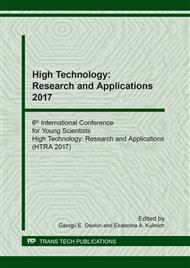[1]
S. Kurtz, K. Ong, E. Lau, F. Mowat, M. Halpern, Projections of primary and revision hip and knee arthroplasty in the United States from 2005 to 2030, The Journal of bone and joint surgery. American volume 89 (2007) 780–785.
DOI: 10.2106/00004623-200704000-00012
Google Scholar
[2]
M. Niinomi, Recent metallic materials for biomedical applications, Metall and Mat Trans A 33 (2002) 477–486.
DOI: 10.1007/s11661-002-0109-2
Google Scholar
[3]
M. Niinomi, Metallic biomaterials, J Artif Organs 11 (2008) 105–110.
Google Scholar
[4]
M.B. Nasab, M.R. Hassan, B.B. Sahari, Metallic Biomaterials of Knee and Hip - A Review, Trends in Biomaterials and Artificial Organs 24 (2010) 69–82.
Google Scholar
[5]
M. Geetha, A.K. Singh, R. Asokamani, A.K. Gogia, Ti based biomaterials, the ultimate choice for orthopaedic implants – A review, Progress in Materials Science 54 (2009) 397–425.
DOI: 10.1016/j.pmatsci.2008.06.004
Google Scholar
[6]
C.N. Elias, J.H.C. Lima, R. Valiev, M.A. Meyers, Biomedical applications of titanium and its alloys, JOM 60 (2008) 46–49.
DOI: 10.1007/s11837-008-0031-1
Google Scholar
[7]
M. Niinomi, M. Nakai, J. Hieda, Development of new metallic alloys for biomedical applications, Acta biomaterialia 8 (2012) 3888–3903.
DOI: 10.1016/j.actbio.2012.06.037
Google Scholar
[8]
M. Niinomi, Mechanical properties of biomedical titanium alloys, Materials Science and Engineering: A 243 (1998) 231–236.
DOI: 10.1016/s0921-5093(97)00806-x
Google Scholar
[9]
D.P. Perl, Relationship of aluminum to Alzheimer's disease, Environ Health Perspect 63 (1985) 149–153.
Google Scholar
[10]
A. Cremasco, A.D. Messias, A.R. Esposito, Duek, Eliana Aparecida de Rezende, R. Caram, Effects of alloying elements on the cytotoxic response of titanium alloys, Materials Science and Engineering: C 31 (2011) 833–839.
DOI: 10.1016/j.msec.2010.12.013
Google Scholar
[11]
M. Niinomi, Recent research and development in titanium alloys for biomedical applications and healthcare goods, Sci. Technol. Adv. Mater. 4 (2003) 445–454.
Google Scholar
[12]
S.G. Fedotov, P.K. Belousov, Elastic constants of alloys of the system titanium– niobium, Fiz. Met. Metalloved 1964 (17) 732–736.
Google Scholar
[13]
S. Banumathy, R.K. Mandal, A.K. Singh, Structure of orthorhombic martensitic phase in binary Ti–Nb alloys, J. Appl. Phys. 106 (2009) 93518.
DOI: 10.1063/1.3255966
Google Scholar
[14]
R. Davis, H.M. Flower, D.R.F. West, Martensitic transformations in Ti-Mo alloys, Journal of Material Science 14 (1979) 712–722.
DOI: 10.1007/bf00772735
Google Scholar
[15]
J.L. Murray, The Nb−Ti (Niobium-Titanium) system, Bulletin of Alloy Phase Diagrams 2 (1981) 55–61.
DOI: 10.1007/bf02873704
Google Scholar
[16]
Y.-H. Hon, J.-Y. Wang, Y.-N. Pan, Composition/Phase Structure and Properties of Titanium-Niobium Alloys, MATERIALS TRANSACTIONS 44 (2003) 2384–2390.
DOI: 10.2320/matertrans.44.2384
Google Scholar
[17]
D.L. Moffat, U.R. Kattner, The stable and metastable Ti-Nb phase diagrams, MTA 19 (1988) 2389–2397.
DOI: 10.1007/bf02645466
Google Scholar
[18]
P.J. Bania, Beta titanium alloys and their role in the titanium industry, JOM 46 (1994) 16–19.
DOI: 10.1007/bf03220742
Google Scholar
[19]
Y. Mantani, M. Tajima, Phase transformation of quenched α" martensite by aging in Ti–Nb alloys, Materials Science and Engineering: A 438-440 (2006) 315–319.
DOI: 10.1016/j.msea.2006.02.180
Google Scholar


